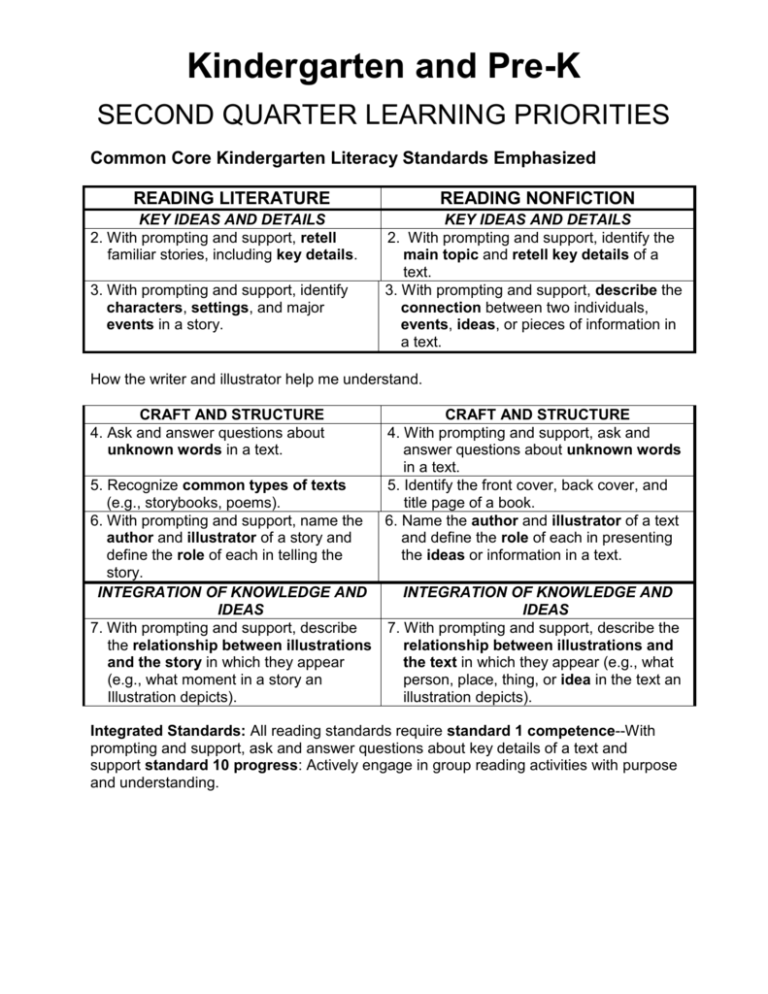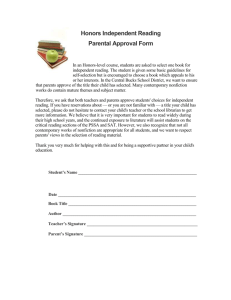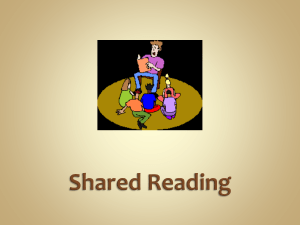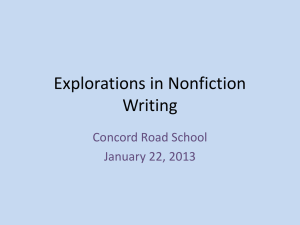
Kindergarten and Pre-K
SECOND QUARTER LEARNING PRIORITIES
Common Core Kindergarten Literacy Standards Emphasized
READING LITERATURE
KEY IDEAS AND DETAILS
2. With prompting and support, retell
familiar stories, including key details.
3. With prompting and support, identify
characters, settings, and major
events in a story.
READING NONFICTION
KEY IDEAS AND DETAILS
2. With prompting and support, identify the
main topic and retell key details of a
text.
3. With prompting and support, describe the
connection between two individuals,
events, ideas, or pieces of information in
a text.
How the writer and illustrator help me understand.
CRAFT AND STRUCTURE
4. Ask and answer questions about
unknown words in a text.
5. Recognize common types of texts
(e.g., storybooks, poems).
6. With prompting and support, name the
author and illustrator of a story and
define the role of each in telling the
story.
INTEGRATION OF KNOWLEDGE AND
IDEAS
7. With prompting and support, describe
the relationship between illustrations
and the story in which they appear
(e.g., what moment in a story an
Illustration depicts).
CRAFT AND STRUCTURE
4. With prompting and support, ask and
answer questions about unknown words
in a text.
5. Identify the front cover, back cover, and
title page of a book.
6. Name the author and illustrator of a text
and define the role of each in presenting
the ideas or information in a text.
INTEGRATION OF KNOWLEDGE AND
IDEAS
7. With prompting and support, describe the
relationship between illustrations and
the text in which they appear (e.g., what
person, place, thing, or idea in the text an
illustration depicts).
Integrated Standards: All reading standards require standard 1 competence--With
prompting and support, ask and answer questions about key details of a text and
support standard 10 progress: Actively engage in group reading activities with purpose
and understanding.
The Speaking and Listening Standards are Keys to Learning
ACROSS the Curriculum
Comprehension and Collaboration
SL.K.1 Participate in collaborative conversations with diverse partners about
kindergarten topics and texts with peers and adults in small and larger groups.
__SL.K.1a Follow agreed-upon rules for discussions (e.g., listening to others and
taking turns speaking about the topics and texts under discussion).
__SL.K.1b Continue a conversation through multiple exchanges.
SL.K.2 Confirm understanding of a text read aloud or information presented orally or
through other media by asking and answering questions about key details and
requesting clarification if something is not understood.
SL.K.3 Ask and answer questions in order to seek help, get information, or clarify
something that is not understood.
Presentation of Knowledge and Ideas
SL.K.4 Describe familiar people, places, things, and events and, with prompting and
support, provide additional detail.
SL.K.5 Add drawings or other visual displays to descriptions as desired to provide
additional detail.
SL.K.6 Speak audibly and express thoughts, feelings, and ideas clearly.
Students exercise Speaking and Listening competencies as they proceed through
the gradual release of responsibility.
SOURCE of Common Core Standards cited in this guide: http://www.corestandards.org
The standards have been issued with a public license that allows them to be republished for any purpose that
supports the standards initiative. © Copyright 2010. National Governors Association Center for Best Practices and
Council of Chief State School Officers. All rights reserved.
http://teacher.depaul.edu
Core Connections 2015
2
LANGUAGE
Kindergarten
This list is set up with lines so that you can check your students’ priorities for
this quarter.
CONVENTIONS IN WRITING AND SPEAKING
1. Observe conventions of grammar and usage.
__a. Print most upper- and lowercase letters.
__b. Write a letter or letters for most consonant and short-vowel sounds (phonemes).
__c. Form regular plural nouns orally by adding /s/ or /es/ (e.g., dog, dogs; wish,
wishes) when speaking.
__d. Understand and use the most frequently occurring prepositions in English (e.g.,
to/from, in/out, on/off, for, of, by, with) when speaking.
__e. Produce and expand complete sentences in shared language and writing
activities.
__f. Understand and use question words (e.g., who, what, where, when, why, how) in
discussions.
2. Observe conventions of capitalization, punctuation, and spelling.
__a. Capitalize the first word in a sentence and the pronoun I.
__b. Name and identify end punctuation, including periods, question marks, and
exclamation points.
__c. Spell simple words phonetically using knowledge of sound-letter relationships.
3. (Begins in grade 3)
VOCABULARY ACQUISITION AND USE
4. Determine word meanings (based on kindergarten reading).
__a. Sort common objects into categories (e.g., shapes, foods) to gain a sense of the
concepts the categories represent.
__b. Identify new meanings for familiar words and apply them accurately (e.g.,
knowing duck as a bird and learning the verb to duck).
__c. Use the most common affixes in English (e.g., -ed, -s, re-, un-, pre-, -ful, -less)
as a clue to the meaning of an unknown word.
5. Understand word relationships.
__a. Build real-life connections between words and their use (e.g., note places at
school that are colorful).
__b. Distinguish shades of meaning among verbs describing the same general action
(e.g., walk, march, strut, prance) by acting out the meanings.
__c. Use common adjectives to distinguish objects (e.g., the small blue square; the
shy white rabbit).
__d. Demonstrate understanding of common verbs and adjectives by relating them to
their opposites (antonyms).
6. Use newly learned words acquired through conversations, reading, and
responding to texts.
http://teacher.depaul.edu
Core Connections 2015
3
Kindergarten: Second Quarter, Weeks 11-12 Learning Priorities
Literature
Genre
Reading Literature
3. With prompting
and support, identify
characters,
settings, and major
events in a story.
Answer with
evidence
Primary
Reading
Resources
Nonfiction
Sources
Science
and
Social Science
DEVELOP
NONFICTION
LITERACY
CCSSRI 2 Relate
information to a
topic
CCSSRI7—explain
how pictures
provide information
about a topic
Phonics/Sight
Words
In addition to
scheduled sight
words include
phrases Fry
Phrases.
Link to Vocabulary
Resources
Week of November 16
__fairy tale __folk tale
__realistic fiction __fable
__ ______________________
Week of November 23
__fairy tale __folk tale
__realistic fiction __fable
__ ______________________
How do the writer and illustrator
help you understand the characters
in a story?
Infer about characters—traits,
motives, and actions
Choose a character.
Who …….. does what ………
How do the writer and illustrator help
you understand the characters in a
story?
Infer about characters—traits,
motives, and actions
Choose a character.
Who …….. does what ………
INFER
why
what
trait
does
that
show?
Answer
evidence
INFER
why
what trait
does that
show?
Answer
evidence
_ picture books _big books
_topic/trade books __videos
__museum exhibit
Integrate NONFICTION reading and
visual resources to explore a topic
with a Focus Question.
Locate and list and picture
information from texts and
illustrations
use words and pictures to tell words
and information that tell about a
topic.
Examples of topical phonics:
_ picture books _big books
_topic/trade books __videos
__museum exhibit
Integrate NONFICTION reading and
visual resources to explore a topic with
a Focus Question.
Locate and list and picture information
from texts and illustrations
use words and pictures to tell words
and information that tell about a topic.
Explain how pictures help provide
information about a topic
Match sound/symbol/picture
Sight Words—use them in phrases
Match sound/symbol/picture
Sight Words—use them in phrases and
and recognize in sentences
recognize in sentences
4b. Identify new meanings for
4b. Identify new meanings for familiar
familiar words and apply them
accurately (e.g., knowing duck as a
bird and learning the verb to duck).
words and apply them accurately (e.g.,
knowing duck as a bird and learning
the verb to duck).
Vocabulary
including Fry
activities
Writing
CCSSW.K.2-explanatory/
informational
Write letters and words or pictures
that show letter sounds
Place words in sequence
Primary Guides
http://teacher.depaul.edu
Write letters and words or pictures that
show letter sounds
Place words in sequence
Primary Guides
Core Connections 2015
4
Kindergarten: Second Quarter, Weeks 13-14 Learning Priorities
Literature Genre
Week of November 30
__fairy tale __folk tale
__realistic fiction __fable
__ ______________________
Week of December 7
__fairy tale __folk tale
__realistic fiction __fable
__ ______________________
Reading Literature
Listen to/read a story. Tell how the Listen to/read a story. Tell how the
CCSSRL.K.1
writer and illustrator help you
writer and illustrator help you
Locate information—key
understand:
understand:
details
Part of the
What Words or
Part of the
What Words or
Answer with evidence—
Story
Pictures tell you
Story
Pictures tell you
literal and inferential
People
People
questions
The Place
The Place
Figure out the theme
Recommended: Dramatize a part
CCSSRLK.6—how the book Recommended: Dramatize a
part of the story.
of the story.
communicates
Primary Reading
Resources
Nonfiction Sources
Science
and Social Science
DEVELOP NONFICTION
LITERACY
CCSSRI.K.2—relate topic
and details.
Phonics/Sight Words
In addition to scheduled
sight words include phrases
Fry Phrases.
Link to Vocabulary
Resources
_ picture books _big books
_ picture books _big books
_topic/trade books __videos
_topic/trade books __videos
__museum exhibit
__museum exhibit
Integrate NONFICTION reading
Integrate NONFICTION reading and
and visual resources to explore visual resources to explore a topic
a topic with a Focus Question.
with a Focus Question.
List important information— List important information—
teacher guides with
teacher guides with questions.
questions.
Then tell what you think is the
Then tell what you think is
most interesting or important
most interesting or important
detail about a topic.
detail about a topic.
Make word-picture glossary.
Make word-picture glossary.
Initial Consonants, onset and
Vocabulary including
Fry activities
Writing
CCSSW.K.2-explanatory/informational
rhyme
Sight Words—use them in
phrases and recognize in
sentences
4b. Identify new meanings for
familiar words and apply them
accurately (e.g., knowing duck
as a bird and learning the verb
to duck).
Write or arrange words in
Initial consonants, onset and
rhyme
Sight Words—use them in phrases
and recognize in sentences
4b. Identify new meanings for
familiar words and apply them
accurately (e.g., knowing duck as a
bird and learning the verb to duck).
Vocabulary Resources
Write sentence.
sentence.
http://teacher.depaul.edu
Core Connections 2015
5
Kindergarten: Second Quarter, Weeks 15-16 Learning Priorities
Literature Genre
Reading Literature
CCSSRLK.6—how
the book
communicates
Week of December 14
__fairy tale __folk tale
__realistic fiction __fable
__ ______________________
Week of January 4
__fairy tale __folk tale
__realistic fiction __fable
__ ______________________
Listen to/read a story. Tell how
Listen to/read a story. Tell how the
the writer and illustrator help you
understand:
Part of the
What Words or
Story
Pictures tell you
People
Their actions and
traits
The Place
What is there?
Primary Reading
Resources
events
Sequence and
figure out which is
most important
The message or theme.
Nonfiction
Sources
Science and
Social Science
DEVELOP
NONFICTION
LITERACY
CCSSR2—relate
topic and details.
CCSSRI.K.7—
integrate information
from text and visuals
Phonics/Sight
Words
In addition to
scheduled sight words
include phrases Fry
Phrases.
Link to Vocabulary
Resources
Vocabulary
including Fry
activities
Writing
CCSSW.K.2-explanatory/
informational
writer and illustrator help you
understand:
Part of the
What Words or Pictures
Story
tell you
People
Their actions and traits
The Place
What is there?
Events
Sequence and figure
out which is most
important
The message or theme.
_ picture books _big books
_topic/trade books __videos
__museum exhibit
Integrate NONFICTION reading
and visual resources to explore a
topic with a Focus Question.
List important information about
a topic from pictures and texts.
Make word-picture glossary.
Draw pictures and write
important facts.
_ picture books _big books
_topic/trade books __videos
__museum exhibit
Integrate NONFICTION reading and
visual resources to explore a topic with
a Focus Question.
List important information about a topic
from pictures and texts.
Make word-picture glossary.
Draw pictures and write important facts.
Final consonants
Sight Words—use them in
Final Consonants
Sight Words—use them in phrases and
phrases and recognize in
sentences
4b. Identify new meanings for
familiar words and apply them
accurately (e.g., knowing duck as
a bird and learning the verb to
duck).
Write or arrange words in
recognize in sentences
4b. Identify new meanings for familiar
words and apply them accurately (e.g.,
knowing duck as a bird and learning the
verb to duck).
Write/arrange words in sentences
sentence
http://teacher.depaul.edu
Core Connections 2015
6
Kindergarten: Second Quarter, Weeks 17-18 Learning Priorities
Week of January 11
Literature Genre
__fairy tale __folk tale
__realistic fiction __fable
__ ______________________
Reading Literature
CCSSRL.K.1, 2, 3,
and 7
Locate information—
key details, events,
characters;
sequence, then
summarize;
Retell then Summarize a story
—What happens? Who are the
characters?
Figure out the main
message/theme
Science and
Social Science
Word Patterns
In addition to
scheduled sight
words include
phrases Fry
Phrases.
Link to Vocabulary
Resources
Phonics: initial, medial, final
Resources
CCSSW.K.2
What do I like about the story (opinion)
_ picture books _big books
_ picture books _big books
_topic/trade books __videos
_topic/trade books __videos
__museum exhibit
__museum exhibit
Integrate NONFICTION reading
Integrate NONFICTION reading and
and visual resources to explore a visual resources to explore a topic
topic with a Focus Question.
with a Focus Question.
Use pictures and text sources
Writing
Retell then Summarize a story
—What happens? Who are the
characters?
What do I like about the story
(opinion)
DEVELOP
NONFICTION
LITERACY
CCSSRI.K.2—relate
details to topic
CCSSRI7—combine
information from text
and visual sources
Vocabulary
__fairy tale __folk tale
__realistic fiction __fable
__ ______________________
Then Infer the main idea/author’s Then Infer the main idea/author’s
message
message
What idea does the writer want
What idea does the writer want me to
me to understand?
understand?
What pictures, sentences, and
What pictures, sentences, and events
events help me understand that
help me understand that idea?
idea?
Primary
Reading
Resources
Nonfiction
Sources
Week of January 18
Use picture and text sources to learn
to learn about a topic.
List and picture important
information.
Summarize what you learned
about the topic.
retell the story.
the topic.
Phonics; initial, medial, final
consonants
Sight Words—use them in
phrases and recognize in
sentences
4c. Use the most common affixes in
English (e.g., -ed, -s, re-, un-, pre-,
-ful, -less) as a clue to the meaning
of an unknown word.
Write sentences
Use captions or sentences to
about a topic.
List and picture important information.
Summarize what you learned about
consonants
Sight Words—use them in phrases
and recognize in sentences
4c. Use the most common affixes in
English (e.g., -ed, -s, re-, un-, pre-, -ful, less) as a clue to the meaning of an
unknown word.
Write sentences
Use captions or sentences to retell
the story.
Retell a story—relates
to literacy—retell story
you read or experience
you had.
http://teacher.depaul.edu
Core Connections 2015
7
Kindergarten: Second Quarter, Weeks 19-20 Learning Priorities
Week of January 25
__fairy tale __folk tale
__realistic fiction __fable
__ ______________________
Literature Genre
Week of February 1
COMPREHENSIVE ASSESSMENT
__fairy tale __folk tale
__realistic fiction __fable
__ ______________________
Reading Literature
CCSSRL.K.1
Read closely/
carefully/completely
Ask/answer how/why questions Comprehensive assessment:
Primary Reading
Resources
question answer evidence
What have we learned about interpreting
stories?
Students analyze an unfamiliar story
identifying characters, traits, sequence,
how the writer and illustrator help you
understand the theme. All explanations
include text-based examples.
with evidence from thetext
and from illustrations.
_ picture books _big books
_ picture books _big books
_topic/trade books __videos
_topic/trade books __videos
__museum exhibit
__museum exhibit
Integrate NONFICTION reading
Integrate NONFICTION reading and
and visual resources to explore a visual resources to explore a topic
topic with a Focus Question.
with a Focus Question.
Nonfiction
Sources
Science and
Social Science
DEVELOP
NONFICTION
LITERACY
CCSSRI.K.2
Relate details to topic
CCSSR7 combine
information from text
and visual sources
Use pictures and text sources
Word Patterns
In addition to
scheduled sight words
include phrases Fry
Phrases.
Link to Vocabulary
Resources
Phonics; initial, medial, final
Vocabulary
Writing
CCSSW.K.2
Retell a story—relates to
literacy—retell story you
read or experience you
had.
to learn about a topic.
Tell how you know that a detail
is important.
List and picture important
information.
Summarize what you learned
about the topic.
Use picture and text sources to learn
about a topic.
Tell how you know a detail is
important.
Then tell how writers and illustrators
tell and show information to help you
understand the topic. Then make
your own page.
Make a first-semester word
consonants
Sight Words—use them in
phrases and recognize in
sentences
4c. Use the most common
affixes in English (e.g., -ed, -s,
re-, un-, pre-, -ful, -less) as a
clue to the meaning of an
unknown word.
Write sentences
Use captions or sentences to
display—what we have learned.
Demonstrate how to use phonics to
decode unfamiliar words.
Write sentences
Use captions or sentences to retell
the story.
retell the story.
http://teacher.depaul.edu
Core Connections 2015
8










